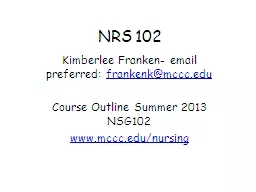

frankenkmcccedu Course Outline Summer 2013 NSG102 wwwmcccedunursing Advice for Success Know your Course Outline Familiarize yourself with program information Preplan and have Plan B in place ID: 719681
Download Presentation The PPT/PDF document "NRS 102 Kimberlee Franken- email prefer..." is the property of its rightful owner. Permission is granted to download and print the materials on this web site for personal, non-commercial use only, and to display it on your personal computer provided you do not modify the materials and that you retain all copyright notices contained in the materials. By downloading content from our website, you accept the terms of this agreement.
Slide1
NRS 102
Kimberlee
Franken- email preferred:
frankenk@mccc.edu
Course Outline Summer 2013 NSG102
www.mccc.edu/nursing
Slide2
Advice for Success
Know your Course Outline
Familiarize yourself with program information
Pre-plan and have ‘Plan B’ in placeTime ManagementStress ManagementSlide3Slide4
Week 1 Learning Objectives
1. Define
and describe the meaning of assessment and the different
types of assessments.
Describe and discuss how cultural and religious differences and
preferences may affect an individual’s lifestyle and health care choices.
3. Describe the importance of the nurse’s self knowledge regarding
prejudgment and bias related to culture and diversity.
Differentiate
between cultural sensitivity and
cultural
competence. Describe why information obtained during a cultural assessment interview is of value. Slide5
Learning Objectives (cont’d.)
6. Identify factors that contribute to diversity.
7. Contrast the diverse needs of various groups of clients/patients based on race, age, gender, sexual orientation, and membership in a vulnerable population.
8. Differentiate between the terms ‘growth’ and ‘development’, and the significance of both to health assessment.9. Describe factors that influence both growth, and development.10. Recognize major development milestones for clients/patients across the lifespan.Slide6
We assess things and people all the time…
(You are all assessing me right now!)
Learning Objective #1
Define
and describe the meaning of assessment and the different
types
of assessments. Slide7
1
st
Step in Nursing Process is…
AssessmentSlide8
Assessment
defined:
The evaluation or estimation of the nature, quality, or ability of someone or something.Slide9
Assessment described:
Initial assessment interview identifies cultural behaviors, health beliefs, illness practices, and cultural needs.
(This information is helpful in planning culturally sensitive care.) Slide10
Culture…Slide11
Learning Objective #2
Cul
tural and religious differences may affect an individual’s lifestyle and healthcare choices…Slide12
Learning Objective #3:
I
t is important for the nurse to have self knowledge about pre judgment and bias related to culture and diversity. Slide13
Cultural Sensitivity
:Slide14
What does culture have to do with health care ?
Cultural patterns are learned by people living together in a society.
Culture influences the customs, beliefs, and values about wellness, health, illness, birth and death. Slide15
Learning Objective #5:
Information obtained during a cultural assessment interview is of value. Slide16
…and why should I care?
Learning Objective #3
Describe the importance of the nurse’s self knowledge regarding prejudgment and bias related to culture and diversity. Slide17
Male dominated culture …
What is the best way to handle this when possible?Slide18
What if your patient is from a different culture than your own, speaks another language, and doesn’t make eye contact with you?
…
Do you get another nurse who is of the same culture? Do you wait and come back later? Slide19
From the Text: (pg. 322)Slide20
Figure 6-1 (continued) Different cultural heritages are parts of the population in America.
Source:
Graph from U.S. Bureau of the Census. (2007). State & County QuickFacts. Retrieved from http://
quickfacts.census.gov/qfd/states/00000.html; Steve Vidler/SuperStock; Robert Caputo/Stock Boston; Arvind Garg/Getty Images, Inc.—Liaison. (Text, pg. 324).
So, what do you think?????Slide21
Diversity…
What is
your
definition of diversity?Slide22
Learning Objective # 6
Diversity defined
: Unique variations among and between individuals, as well as those defined by genetics and cultural background, but are refined by experience and personal choice. (Text, pg. 398).Slide23
Factors contributing to diversity include:
Age
Gender
Sexual OrientationSocioeconomicsLiving ArrangementsRaceCultureEducationLife ExperiencesSlide24
Growth
vs.
Development…Slide25
Growth:
Physical change and an increase in size. It can be measured quantitatively. Slide26
Development:
An increase in the complexity of function and skill progression, the capacity of skill and a person to adapt to the environment.
***
Development is the behavioral aspect of growth (e.g., a person develops the ability to walk, to talk, and to run.)Slide27
Factors that influence both growth and development:
Genetics
Prenatal Influences
Environmental InfluencesCultural InfluencesNutritionFamily and ParentingHealthSlide28
End of Week 1